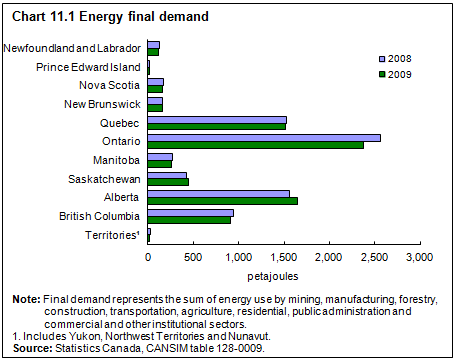Energy
Archived Content
Information identified as archived is provided for reference, research or recordkeeping purposes. It is not subject to the Government of Canada Web Standards and has not been altered or updated since it was archived. Please "contact us" to request a format other than those available.
Related information
The energy sector plays a major role in Canada's economy. In 2009, energy contributed 6.7% to gross domestic product (GDP), a decrease from 6.9% in 2008. As a result of the 2008–2009 recession, the sector saw declines in domestic consumption, exports and production.
Energy consumption and production
Canadians cut energy consumption in 2009 for a second consecutive year, as their energy use fell in all major sectors of the economy. Canada's total energy consumption (measured as final demand) in 2009 was 7,650 petajoules, down 1.9% from 2008. One petajoule is enough energy to run the Montréal subway system for a year.
Most (31%) of Canada's energy use occurs in the transportation sector, where final demand fell 1.4% from 2008 to 2009. Mining, manufacturing, forestry and construction consumed 29% of final demand and reduced their combined energy use by 1.5%. The biggest proportional decline in consumption was in the combined residential and agricultural sectors, where energy use dropped 4.3%.
Less demand meant that energy production from all sources—oil, natural gas, coal, hydro, nuclear, wind and tidal power—was cut back in 2009. Output of crude oil and equivalent products totalled 158.1 million cubic metres in 2009, a 0.5% decrease from 2008. This followed a decrease of 1.8% from 2007. Because wellhead prices for crude oil were lower in 2009, the value of that output dropped 33% to $61.6 billion, down from $91.8 billion in 2008.
Natural gas production declined 6.4% in 2009, following a decline of 4.5% in 2008. Exports to the United States fell 7.1%. Exports accounted for 59% of Canada's production of marketable natural gas in 2009, with Canadian production accounting for 14% of the natural gas consumed in the United States.
Prices were also lower for natural gas in 2009, so the value of Canada's marketable production dropped from 2008 to 2009 by 53% to $20.9 billion. The value of natural gas by-products totalled $5.8 billion in 2009, down 48% from 2008.
Canada's refineries reduced prod-uction year-over-year by 2.1%, as total demand for their products declined 3.1% in 2009—gasoline was the exception. Demand for gasoline rose 1.1% over the course of the year. One-fifth (21%) of refined petroleum products were exported, but the volume of exports was 5.1% lower than in 2008.
Spending to cut energy use and pollutants
In 2008, businesses spent $1.7 billion on energy-related processes or technologies designed to reduce the amount of energy they use or the amount of pollutants they produce. This spending was $301.7 million less than in 2006. Operating expenditures for these technologies were $1.1 billion, a $64.3 million increase from 2006. However, businesses' capital investment in energy-related technologies dropped 39%.
The electric power generation, transmission and distribution industry spends more than any other industry on energy-related technologies. In 2008, the industry spent over half a billion dollars, up $27.4 million from 2006—an increase largely because of the higher operating costs of renewable energy technologies.
In 2008, the oil and gas extraction industry spent $393.4 million on energy-related processes and technologies. From 2006 to 2008, capital expenditures for these technologies decreased by $385.6 million. The technologies used most often by this industry are solar energy systems or equipment and technology to recover or reuse waste energy. From 2006 to 2008, the oil and gas extraction industry's spending on energy-related technologies shifted from capital investment toward operating expenditures.
Businesses' energy use
More than 1 out of 4 (27%) Canadian businesses are using energy-related processes or technologies. The most widely reported processes or technologies (used by between 10% and 13% of businesses) were energy management or monitoring systems, waste energy recovery technologies and energy audits.
The size of the business also plays a role in the use of energy-related processes or technologies. Of businesses with 1,000 or more employees, 81% use energy-related processes or technologies, compared with 21% of businesses with fewer than 100 employees.
- Date modified:

